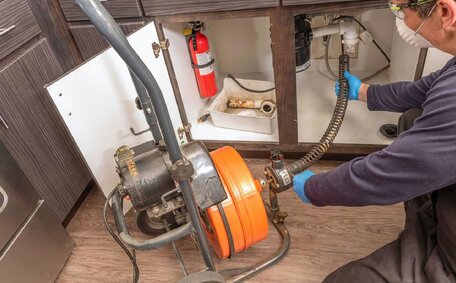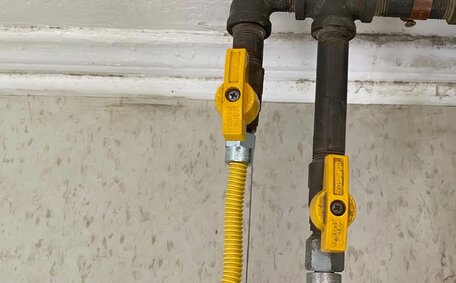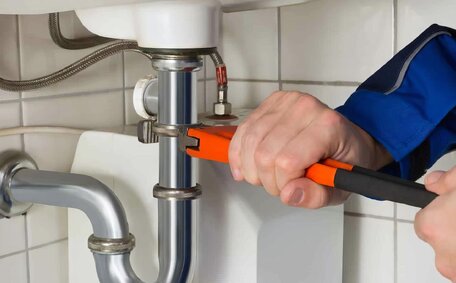Understanding Your Hot Water System and Thermostat
Hot water systems in many homes and businesses use a thermostat to regulate water temperature, which is key for achieving energy efficiency. Properly adjusting your hot water system’s thermostat can lead to greater efficiency and energy savings.
Around 21% of household energy use in Australia goes toward heating water. Optimal thermostat settings reduce energy usage while preserving comfort and safety. Thermostats should be set to 60 degrees Celsius to prevent Legionella bacteria growth, ensuring it’s not set too high as excess heat is wasted.
Insulating hot water pipes retains heat, thereby saving energy otherwise spent on reheating. Annual maintenance, including checking the relief valve and flushing the system, optimises performance and energy efficiency. And installing energy-efficient showerheads, tap aerators and other fixtures reduces hot water needs.
Work with a licenced Abbotsbury plumber to safely inspect your system and adjust thermostat settings for efficiency. Minor adjustments can yield significant savings on energy bills and reduce environmental impact without sacrificing hot water convenience.
How Thermostats Regulate Temperature
Thermostats regulate your hot water system’s temperature through their connection to the heating element and pump. When the water in the storage tank drops below the set temperature, the thermostat triggers the heating process to warm it back up.
Thermostats typically have a wax-like substance that expands with heat and contracts when cool. As the water temperature vacillates, the wax responds by toggling the switch to either commence or terminate heating.
Thermostats regulate hot water temperature by:
- Turning the heating element or gas burner on when the tank water falls to a certain threshold below the set temperature.
- Turning the heating off once the temperature reaches the desired setting.
- Preventing the water from reaching a higher temperature than the maximum safe level.
Thermostat dials may not always reflect accurate temperatures. To measure your hot water’s precise temperature, use an aquarium or cooking thermometer.
Work with your Abbotsbury plumber to choose the optimal thermostat setting for efficiency and safety in your home’s specific hot water system.
Optimal Temperature Settings for Efficiency and Bacterial Prevention
Finding the right hot water system thermostat setting comes down to balancing efficiency with safety. Setting your system higher than necessary increases the risk of Legionella bacteria growth and wastes energy.
For gas-electric storage tanks, a temperature setting at 60°C is ideal to prevent Legionella and avoid wasting energy. Temperatures between 55°C and 60°C are required to kill this potentially deadly bacteria.
With gas water heaters, such as continuous flow models, thermostats should not exceed 50°C to curtail scalding risks. These compact systems heat water on demand rather than storing hot water.
They can ensure safety whilst maximising the energy saving benefits through these optimal thermostat levels and additional efficiency measures like insulation and regular maintenance.
Tips for Storage Tank Systems
To improve storage tank system efficiency, consider the following strategies:
- Insulating your hot water storage tank, pipes and valves reduces the amount of energy used by lessening standby heat loss. Savings of $200+ per year are possible.
- A thermostat setting of 60°C prevents Legionella growth and minimises heat waste.
- Installing heat traps on the hot and cold pipes reduces the amount of hot water mixing back into the cold line.
- Consider a timer to switch off heating elements during low usage periods like overnight and weekends.
Work with a qualified local plumber to tailor storage tank system settings and accessories for optimal efficiency. Proper installation and maintenance can save you trouble and keep your hot water appliances safely performing for years to come.
Tips for Continuous Flow Systems
Continuous flow systems operate more efficiently than traditional storage tanks, heating water on demand. Instead of keeping a reservoir of constantly heated water, these on-demand systems utilise advanced heat exchangers to warm water as it’s needed.
Consider these tips to maximise the efficiency of continuous flow systems:
- Set the thermostat no higher than 50°C to prevent scalding accidents while also avoiding excessive energy waste from overheating.
- Insulate the external piping to retain heat in the system.
- Install heat traps which prevent hot water mixing back into cold pipes.
- Use timer controls to switch the system off during extended no-use periods.
- Service annually and flush heat exchanger mineral buildup which reduces effectiveness.
Compared to storage systems, the lower optimal temperature settings make continuous flow water heaters more energy efficient. Work with your qualified Abbotsbury plumber to tailor accessories and maintenance to your specific model for optimal safety and savings.
DIY Guide to Safely Adjusting Your Thermostat
Adjusting your hot water system’s thermostat is an easy DIY task that can optimise efficiency, but safety should be the top priority. Follow these steps for accurate, safe thermostat tweaks:
- You might able to locate the access panel and cautiously remove it to unveil the thermostat.
- Use an aquarium or cooking thermometer to test the current water temperature.
- Refer to your water heater temperature guidelines from the manufacturer—typically about 60°C for storage tanks and 50°C for continuous flow.
- Gently adjust the thermostat down on the dial, checking the thermometer regularly until you reach the preferred temperature.
- Replace the access panel once finished.
- Label the new setting for easy reference and continue monitoring water temperature.
If unsure about any step, contact the licenced professionals at Abbotsbury Plumbing on 1300 349 338 for assistance adjusting your hot water system’s thermostat.
Insulating Your Hot Water System and Pipes
Insulating your system reduces your hot water’s energy use by decreasing the frequency of reheating. Reducing heat loss from hot water appliances and plumbing can lower reheating costs. Proper insulation can result in savings by reducing water heating energy loss by over 15%.
Insulating materials like pre-formed pipe lagging wraps, foam sleeves and batts are available from hardware stores to wrap around hot water systems and pipes. Installing these can reduce standby heat dissipation, saving households around $200+ per year.
- Ensure all hot water pipes and valves are adequately covered, not just the storage tank itself.
- Choose insulation products designed specifically for hot water plumbing, rated to withstand temperatures exceeding 100°C.
- For DIY insulation, take safety precautions like wearing protective gloves when handling wraps.
For correctly sized, professionally installed insulation speak to your licenced Abbotsbury plumber. Tailoring insulation levels to your hot water appliance can optimise savings while maintaining convenient access for servicing.
Installing Heat Traps and Anti-Convection Valves
Installing heat traps and anti-convection valves can help improve the efficiency of your hot water system in Abbotsbury. Here’s how they work:
Heat Traps
Heat traps are simple devices that prevent heated water in your hot water pipes from migrating back into the cold water pipes. This mixing leads to avoidable heat loss. Heat traps allow water to flow one way into your water heater while blocking backward flow into the cold line.
Anti-Convection Valves
These valves stop thermosyphoning, which is the natural circulation of hot water rising and cooler water falling in pipes. This convection process causes increased heat loss from hot water pipes. Anti-convection valves stop unnecessary water movement when fixtures are shut off.
Installing heat traps and anti-convection valves enhances efficiency and reduces heat loss. Contact the licenced professionals at Abbotsbury Plumbing on 1300 349 338 to understand if these accessories could benefit your hot water system.
The Importance of Regular Maintenance
Regularly maintaining your hot water system enhances efficiency and longevity. Annual mineral buildup flushing, biannual valve testing, and regular inspections for leaks can optimise system performance.
Preventative maintenance reduces the risk of expensive emergency repairs. It also keeps energy bills lower by maintaining your system at peak heating capacity. Catching minor issues early on stops them compounding into major problems.
For continuous flow systems, descaling the internal heat exchanger is essential to restore maximum hot water flow. Over time, scale deposits restrict water movement, forcing the appliance to work harder.
Storage water heaters benefit from annual flushing to clear sediment accumulation in the tank. This maximises heating element contact with water so less energy is required.
For expert maintenance, reach out to Abbotsbury Plumbing at 1300 349 338. Investing in regular preventative upkeep now saves money and headaches later.
Choosing Energy and Water Efficient Fixtures
Fixtures compatible with electric water heaters can greatly improve the efficiency of your hot water setup in Abbotsbury. Low flow showerheads, tap aerators and other accessories help reduce your home’s hot water requirements.
Some benefits of efficient fixtures include:
- Low flow showerheads can halve water usage, significantly reducing heating demands.
- Aerators on basin and kitchen taps mix air into the stream, maintaining pressure while lowering flow.
- Thermostatic mixing valves accurately blend hot and cold water, preventing waste from faucet guesswork.
- Water efficient toilets, dishwashers and washing machines also decrease hot water needs.
Combining a well-adjusted thermostat with water-efficient tapware and appliances enhances your system’s performance. This allows you to save energy and money on water heating bills.
Contact the helpful staff at Abbotsbury Plumbing on 1300 349 338 for advice selecting suitable energy and water saving fixtures for your home or business.
Preventing Scalds and Bacterial Growth
Proper hot water temperatures are critical for preventing scalds and the growth of bacteria that cause illness. Temperatures higher than necessary can inflict burns, while those too tepid can harbour bacterial risks.
Water temperatures above 50°C can result in severe burns rapidly, in under five seconds.
Keep storage tank systems below 60°C to prevent Legionella bacteria development. Continuous flow heaters with lower temperature settings don’t harbour bacteria internally.
Work with your qualified Abbotsbury plumber to tailor your hot water system’s thermostat and accessories to maintain temperatures from 50-60°C. This prevents scalds while still hot enough to kill Legionella bacteria.
If dealing with scalds or symptoms suggestive of Legionnaires’ Disease from bacteria, promptly call Abbotsbury Plumbing at 1300 349 338 for urgent assistance.






